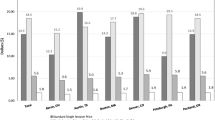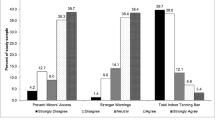Abstract
There is emerging evidence for the relationship between indoor tanning and melanoma. Eighty-five indoor tanning facilities in New York City were observed to determine number of tanning machines, pricing, promotions, products, and hours. Census data by zip code was used to determine population density, gender, race, age, percent living in poverty, percent unemployed, and percent college educated of areas in which tanning facilities were located. Pricing varied by the type of machine, number of sessions purchased, and single versus bundled sessions. Facilities were located in areas that had greater population density and slightly greater median age. Compared with the zip code areas with no facilities, those with tanning facilities had a higher proportion of white residents; a lower proportion of residents living in poverty and unemployed; and a higher proportion of residents with a college education. Our data suggest that the strategic location of facilities and promotions used in NYC seek to maximize patronage by those with comparatively high levels of income and education and who may be more influenced by the social desirability of artificial tanning. Long-term interventions aimed at changing social norms regarding tan skin are needed.
Similar content being viewed by others
References
American Cancer Society. (2009). Cancer facts and figures. Atlanta, GA: American Cancer Society.
National Cancer Institute. Skin cancer. (2010a). Available at: http://www.cancer.gov/cancertopics/types/skin. Accessed 1 Aug 2010.
National Cancer Institute. Melanoma. (2010b). Available at: http://www.cancer.gov/cancertopics/types/melanoma. Accessed 1 Aug 2010.
American Academy of Dermatology. Skin cancer fact sheet. (2008). Available at: http://www.aad.org/media/background/factsheets/fact_skincancer.html. Accessed 1 Aug 2010.
Seidler, A. M., Pennie, M. L., Veledar, E., Culler, S. D., & Chen, S. C. (2010). Economic burden of melanoma in the elderly population: Population-based analysis of the surveillance, epidemiology, and end results (SEER)-medicare data. Archives of Dermatology, 146(3), 249–256.
Abdulla, F. R., Feldman, S. R., Williford, P. M., Krowchuk, D., & Kaur, M. (2005). Tanning and skin cancer. Pediatric Dermatology, 22(6), 501–512.
Schulman, J. M., & Fisher, D. E. (2009). Indoor ultraviolet tanning and skin cancer: Health risks and opportunities. Current Opinion in Oncology, 21(2), 144–149.
World Health Organization (WHO). Sunbeds, tanning and UV exposure. (2005). Available at: http://www.who.int/mediacentre/factsheets/fs287/en/. Accessed 1 Aug 2010.
Hoerster, K. D., Garrow, R. L., Mayer, J. A., et al. (2009). Density of indoor tanning facilities in 116 large US cities. American Journal of Preventive Medicine, 36(3), 243–246.
Cokkinides, V. E., Weinstock, M. A., O’Connell, M. C., & Thun, M. J. (2002). Use of indoor tanning sunlamps by US youth, ages 11–18 years, and by their parent or guardian caregivers: Prevalence and correlates. Pediatrics, 109(6), 1124–1130.
Geller, A. C., Colditz, G., Oliveria, S., et al. (2002). Use of sunscreen, sunburning rates, and tanning bed use among more than 10,000 US children and adolescents. Pediatrics, 109(6), 1009–1014.
Centers for Disease Control and Prevention. (2006). QuickStats: Percentage of teens aged 14–17 years who used indoor tanning devices during the preceding 12 months, by sex and age—United States, 2005. MMWR, 55, 1101.
Demko, C. A., Borawski, E. A., Debanne, S. M., Cooper, K. D., & Stange, K. C. (2003). Use of indoor tanning facilities by white adolescents in the United States. Archives of Pediatric and Adolescent Medicine, 157(9), 854–860.
Stryker, J. E., Yaroch, A. L., Moser, R. P., Atienza, A., & Glanz, K. (2007). Prevalence of sunless tanning product use and related behaviors among adults in the United States: Results from a national survey. Journal of the American Academy of Dermatology, 56, 387–390.
Heckman, C. J., Coups, E. J., & Manne, S. L. (2008). Prevalence and correlates of indoor tanning among US adults. Journal of the American Academy of Dermatology, 58(5), 769–780.
Knight, J. M., Kirincich, A. N., Farmer, E. R., & Hood, A. F. (2002). Awareness of the risks of tanning lamps does not influence behavior among college students. Archives of Dermatology, 138(10), 1311–1315.
National Conference of State Legislatures. Tanning restrictions for minors—A state-by-state comparison. (2010). Available at: http://www.ncsl.org/default.aspx?tabid=14394#statelws. Accessed 6 Nov 2010.
Mayer, J. A., Hoerster, K. D., Pichon, L. C., Rubio, D. A., Woodruff, S. I., & Forster, J. L. (2008). Enforcement of state indoor tanning laws in the United States. Prevention of Chronic Disease, 5(4), A125.
Hester, E. J., Johnson, K. R., Crane, L. A., Schilling, L. M., & Dellavalle, R. P. (2004). Indoor UV tanning operator opinion regarding youth access: An electronic survey. Journal of the American Academy of Dermatology, 51(5), 814–816.
Fairchild, A. L., & Gemson, D. H. (1992). Safety information provided to customers of New York City sun tanning salons. American Journal of Preventive Medicine, 8(6), 381–383.
Heilig, L. F., D’Ambrosia, R., Drake, A. L., Dellavalle, R. P., & Hester, E. J. (2005). A case for informed consent? Indoor UV tanning facility operator’s provision of health risks information (United States). Cancer Causes and Control, 16(5), 557–560.
Brouse, C. H., Basch, C. E., & Neugut, A. I. Warning signs in tanning salons in New York city: Implications for skin cancer prevention. Preventing Chronic Disease (in Press).
Dennis, L. K., Lowe, J. B., & Snetselaar, L. G. (2009). Tanning behaviour among young frequent tanners is related to attitudes and not lack of knowledge about the dangers. Health Education Journal, 68(3), 232–243.
Lamanna, L. M. (2004). College students’ knowledge and attitudes about cancer and perceived risks of developing skin cancer. Dermatology Nursing, 16(2), 161–164.
Stanton, W. R., Moffatt, J., & Clavarino, A. (2005). Community perceptions of adequate levels and reasons for skin protection. Behavioral Medicine, 31(1), 5–15.
Spencer, J. M., & Amonetter, R. A. (1995). Indoor tanning: Risks, benefits, and future trends. Journal of the American Academy of Dermatology, 33, 288–298.
Fiala, B., Kopp, M., & Gunther, V. (1997). Why do young women use sunbeds? A comparative psychological study. British Journal of Dermatology, 137, 950–954.
Hillhouse, J. J., Turrisi, R., & Kastner, M. (2000). Modeling tanning salon behavioral tendencies using appearance motivation, self monitoring and the theory of planned behavior. Health Education Research, 15, 405–414.
Leary, M. R., & Jones, J. L. (1993). The social psychology of tanning and sunscreen use: Self-presentational motives as a predictor of health risk. Journal of Applied Social Psychology, 23, 1390–1406.
Miller, A., Ashton, W., McHoskey, J., & Gimbel, J. (1990). What price attractiveness? Stereotype and risk factors in suntanning behaviour. Journal of Applied Social Psychology, 20, 1272.
US Census Bureau. American Factfinder: Census 2000 summary file 1 (SF 1) 100-Percent Data. (2000a). Available at: http://factfinder.census.gov/home/saff/main.html?_lang=en. Accessed 1 Aug 2010.
US Census Bureau. American Factfinder. Census 2000 summary file 3 (SF 3)—Sample Data. (2000b). Available at: http://factfinder.census.gov/home/saff/main.html?_lang=en. Accessed 1 Aug 2010.
Ortiz, C. A., Goodwin, J. S., & Freeman, J. L. (2005). The effect of socioeconomic factors on incidence, stage at diagnosis and survival of cutaneous melanoma. Medical Science Monitor, 11(5), 163–172.
Kwon, H. T., Mayer, J. A., Walker, K. K., Yu, H., Lewis, E. C., & Belch, G. E. (2002). Promotion of frequent tanning sessions by indoor tanning facilities: Two studies. Journal of the American Academy of Dermatology, 46(5), 700–705.
Mosher, C. E., & Danoff-Burg, S. (2010). Addiction to indoor tanning: relation to anxiety, depression, and substance use. Archives of Dermatology, 146(4), 412–417.
Greenman, J., & Jones, D. A. (2010). Comparison of advertising strategies between the indoor tanning and tobacco industries. Journal of the American Academy of Dermatology, 62(4), 685. e1–18.
Culley, C. A., Mayer, J. A., Eckhardt, L., Busic, A. J., Eichenfield, L. F., Sallis, J. F., et al. (2001). Compliance with federal and state legislation by indoor tanning facilities in San Diego. Journal of the American Association of Dermatology, 44(1), 53–60.
Acknowledgments
This work was supported by the National Cancer Institute (R25 CA094601) to C.H.B.
Author information
Authors and Affiliations
Corresponding author
Rights and permissions
About this article
Cite this article
Brouse, C.H., Hillyer, G.C., Basch, C.E. et al. Geography, Facilities, and Promotional Strategies Used to Encourage Indoor Tanning in New York City. J Community Health 36, 635–639 (2011). https://doi.org/10.1007/s10900-010-9354-2
Published:
Issue Date:
DOI: https://doi.org/10.1007/s10900-010-9354-2




